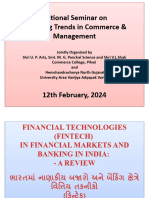0% found this document useful (0 votes)
44 views18 pagesFinTech Essentials for Professionals
Its something related to management.
Uploaded by
gokul kumarCopyright
© © All Rights Reserved
We take content rights seriously. If you suspect this is your content, claim it here.
Available Formats
Download as PDF, TXT or read online on Scribd
0% found this document useful (0 votes)
44 views18 pagesFinTech Essentials for Professionals
Its something related to management.
Uploaded by
gokul kumarCopyright
© © All Rights Reserved
We take content rights seriously. If you suspect this is your content, claim it here.
Available Formats
Download as PDF, TXT or read online on Scribd
/ 18






















































































